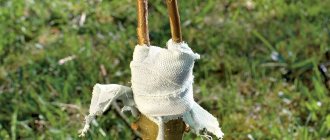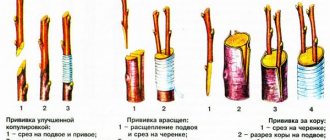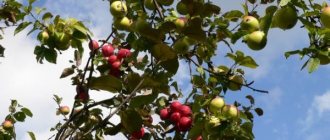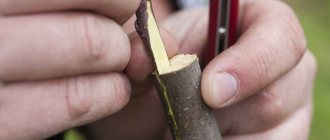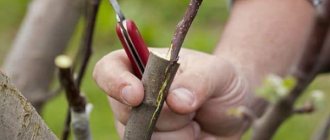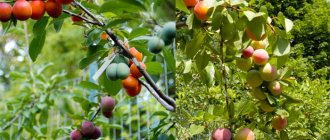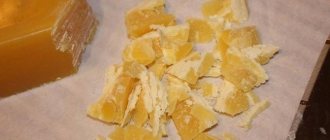What can you graft an apple tree on?
The expression that like crosses with like is undeniable. The apple tree will do best on an apple tree. This does not mean that other rootstocks are not used for grafting. So, let’s look in detail at what to graft an apple tree on.
Important! The closest group of plants on which such work can be successfully carried out are pome crops. Fruit trees of this species are genetically similar to apple trees, so their survival rate is good.
Grafting on berry trees successful . Red rowan and chokeberry are often used as rootstocks for the production of seedlings. The combination usually takes place without much difficulty. But such vaccinations have features and limitations.
Grafting an apple tree onto chokeberry can be successful.
Attempts to cross apple trees with stone fruit crops rarely achieve positive results . But such experiments are also successful.
Michurin's teaching says that everything can be grafted onto everything! The main thing is to do it right.
Features of plum
Plum grown from seed has a number of positive properties:
- the plant forms a powerful root system, which can provide nutrition for a productive tree;
- plum is a flexible stone fruit that can interact not only with plums or other stone fruit trees. Pome crops also take root on this scion;
- The scion has high winter hardiness. Its roots do not freeze even during severe frosts, which are observed in December in the absence of snow cover;
- Tall and dwarf trees are found in nature. Using one type or another allows gardeners to create different types of gardens.
Interesting experiments
Breeders attempting interfamily grafting experimented a lot and got good results.
L. Daniel at the beginning of the 20th century grafted roses onto oak, grapes onto roses, and even combined coniferous spruce with deciduous linden.
In the 20s of the same century, Yakovlev P.N. and Michurin I.V. grafted lemon cuttings onto a pear tree and the citrus grew successfully for more than four years. Examples of reverse grafting have shown that the grown cuttings take on the properties of the rootstock. Pears became evergreen and stopped shedding their leaves during the cold season. In both cases, fruits were obtained.
Since apple and pear trees belong to the same family , you can try grafting an apple tree onto a pear tree. You can also try to graft an apple tree onto a lemon tree and vice versa, but only in greenhouse conditions. Otherwise, the very first winter will destroy the experiment.
Under Soviet rule, there was a joke about breeders who grafted an apple tree onto a birch tree. She prompted many summer residents to experiment. Most often they tried to “make a fairy tale come true.” There have been many attempts to graft an apple tree onto a birch tree in amateur gardening. There were those who went further - they grafted apple cuttings onto aspen, maple, and poplar.
This activity is not meaningless. If there were no such curious people, many varieties of fruit trees would not appear at all. We would have to be content with what traditionally grows in nearby gardens.
It was curiosity and the desire to improve different crops that led to the creation of southern varieties on winter-hardy rootstocks. zoned columnar fruit trees appeared and the varietal qualities of fruit harvests improved.
When experimenting with grafting distant families, it is necessary to take into account not only the qualities of the rootstock.
The scion must actively participate in the life of the tree and supply it with nutrients, otherwise the experiment is doomed to failure.
Why are trees grafted?
If you plant a plum seed, a seedling will appear the next year. Its properties will depend not only on the variety from which the seed was obtained. The properties of the second parent (the producer of pollen involved in pollination of the mother plant) will certainly be present. Most often, effective pollination occurs not within a variety, but when one is pollinated by another.
A new genetic set in a growing tree rarely gives the desired properties. Typically, when cross-pollinated, plants tend to return to their original form. Only with the targeted artificial creation of a new variety can the desired properties be achieved.
A seedling without grafting begins to bloom and bear fruit no earlier than the fifth to seventh year after the sprout appears. Fruiting is delayed for a long time. If you graft a one-year-old seedling and use a fruit-bearing branch as a scion, then after a year the new tree will begin to bear its first fruits. The mechanism for fruiting will begin much earlier.
Vaccination allows:
- grow fruit trees of a certain variety with predetermined properties;
- get a harvest from seedlings in the shortest possible time;
- using different types of rootstocks to obtain tall and dwarf trees. On a winter-hardy rootstock, obtain planting material that can withstand severe frosts;
- expand the distribution range of heat-loving plants in areas where certain types of trees were not previously expected to be grown.
Attention! By grafting plants, you can have an effective garden with a wide variety of varieties.
Apple tree on apple tree
Despite the apparent simplicity and close relationships, grafting an apple tree on an apple tree is not always successful. Varieties may be incompatible .
Varietal compliance
Grafting is easiest if the rootstock and scion are of the same variety . It’s a pity, the need for such work arises extremely rarely.
This method will work:
- To renew old trees;
- For propagation of local varieties.
More on Tele4n.Net:
Aboriginal apple tree: description of the variety with photos, proper planting and care
You can graft several shoots onto a living stump left over from an old apple tree. In this case, it is worth using bark or split . The renewal will be more successful if the cutting is grafted onto one of the skeletal branches.
Grafting on a live stump.
The local variety can be propagated by simply sowing seeds; the seedlings will grow on their own. They will be wild, but it will be possible to graft a cutting from a cultivated tree onto them.
The use of grafting speeds up fruiting time by almost half. For these purposes, nurseries more often use budding grafting.
In other cases, the method of varietal identification is not justified.
Important! Antonovka seedlings are a universal rootstock for cultivated varieties. This quality allowed the variety to become the most widely used in nurseries in the middle zone.
Criteria for selecting varieties
Having decided to get a new variety in the garden, you need to evaluate the compatibility of plants . Main criteria :
- Rates of growth;
- Fruit size;
- Fruiting dates.
Tree growth rate
It is difficult for varieties with different growth rates to take root. The advance in the development of the scion (or rootstock) makes the graft short-lived. Sooner or later it dries out or breaks off
Fruit size
Grafting of cultivated varieties onto small-fruited apple trees: ranetki and china. Among them there are many varieties that have exceptional winter hardiness.
Cuttings of southern varieties, grafted onto small-fruited apple trees, winter well in central and northern latitudes. This method is often used to produce seedlings.
Advice! Some large-fruited varieties of apple trees are incompatible with Chinese apples: Anis, Borovinka, Ranet Simirenko, Antonovka, Cinnamon Polosatoe, Grushovka Moskovskaya, etc.
Another advantage of small fruits is their short stature. Using them as a rootstock for tall apple trees greatly reduces the height of the latter.
The crown becomes compact, and the tree is more convenient for the gardener. Harvesting becomes easier and daily maintenance is simpler.
Not every apple tree with small fruits is suitable for grafting. The variety must be selected according to its characteristics. Among ranetkas there are many varieties that have absolutely no frost resistance and low growth.
Among the winter-hardy low-standard varieties we can recommend :
- Bagryanka;
- Dobrynya;
- Kisilevka;
- Ranetka purple and canned;
- Severyanka.
Dobrynya.
Ranetka is purple.
Northern woman.
Fruiting dates
One of the main postulates is that only varieties close in maturity should be grafted:
- Late summer varieties can be grafted onto summer varieties, or, in extreme cases, autumn ones;
- For autumn - late summer and early winter;
- For winter only late autumn.
To prove this theory, the biological characteristics of the varieties are given. The almost simultaneous start of the growing season, the equal speed of development and the period of preparation for winter give such combinations a greater chance of growing together.
A winter variety grafted onto a summer apple tree will be suppressed and will not have enough nutrition by the time it ripens. As a result, there is a risk of fruit falling and incomplete ripeness .
The theory is correct, but how can we explain the appearance of “family” apple trees? Breeders successfully graft and distribute trees on which summer, autumn and winter varieties ripen in stages.
Properly selected varieties, even with different fruiting periods, give good results . The selection requires knowledge and years of hard work.
In practice, to obtain a guaranteed result, it is better to adhere to already proven postulates.
You can also watch the video on how to grow several varieties of apple trees on one wildflower rootstock:
Family Tree
If you want to have a “family” tree, it is worth studying experience and learning more about the combination of varieties.
expensive for sale and appear rarely . It is technologically easier for nursery owners to grow many fruits of the same variety. The production period for a “family tree” is 5 years, as different varieties are grafted into a well-formed crown. This is possible only when the seedling is four years old.
grow a young multi-varietal tree yourself much faster . To do this, you need to buy a three to four year old seedling of one variety and plant several additional ones on it. It is even easier to graft new varieties into the crown of mature trees.
In response to the question whether it is possible to graft three varieties on one apple tree, experts confidently answer: “At least ten!” A tall apple tree with a dozen varieties is capable of bearing fruit for 30-40 years. One such tree can completely provide a large family with apples. This requires careful care.
It is better to create two varieties on a tree that will receive sufficient nutrition and light than ten.
“Magic” apple tree, on which 250 varieties grow.
Attention! The more varieties there are on one tree, the harder their existence will be.
More on Tele4n.Net:
Columnar apple trees: varieties for the Urals and reviews
The struggle for nutrients will inevitably lead to the better development of some varieties and the suppression of others. A way to prevent this deficiency is to form a bowl-shaped crown , with each trunk representing one variety.
Amateur gardeners do not have time to engage in biological research and compare the survival rates of different apple trees with each other. It’s easier to find out what varieties breeders combine when producing “family” trees and repeat these combinations on your own seedlings.
The most common connections:
- Glory to the Winners (summer) - Renet Simirenko (late winter) - Golden Delicious (winter);
- Antonovka (autumn) – Melba (summer) – White filling (summer) – Renet Simirenko (late winter);
- Melba (summer) - White filling (summer) - Lungwort (summer) - Grushovka Moskovskaya (summer);
- Bryanskoe (early winter) - Alesya (late winter).
Glory to the Winners, Renet Simirenko, Golden Delicious.
Clockwise: Antonovka, Melba, Belyi naliv, Renet Simirenko.
Clockwise: Melba, Belyi Naliv, Medunitsa, Grushovka Moskovskaya.
Bryanskoye, Alesya.
If the size of the plot allows, it is better to plant 2-3 trees and plant no more than four varieties on each tree, similar in terms of ripening.
A family tree can be created based on a columnar apple tree. To do this, in the first year the apical shoot is cut off. The plant will produce several branches, each of which will serve as a rootstock.
Maintain columnarity by pruning . If you do not do this, you will end up with a dwarf tree with different fruits. The varieties for the scion should be selected carefully. The main criterion is the slow development of the variety.
If you graft a columnar apple tree onto a medium-sized rootstock or pear, you will not be able to maintain its shape. The appearance of the column is determined by the rootstock.
For the bark
The technology is reminiscent of budding, only a cutting is implanted instead of a bud. A freshly cut plum branch is chosen as a rootstock. The bark is cut to a length of 5 cm and carefully turned outward. The end of the grafted branch is sharpened at an angle of 45°, the cut is driven under the bark, and wrapped with tape.
The advantage of this method is its ease of execution and the absence of the need to connect the cambial layers. Several branches can be grafted onto one plum branch. The disadvantage is considered to be weak adhesion, which reduces the percentage of engraftment.
On different cultures
Pomaceae
The second place in dacha experiments is taken by grafting apple trees onto pome crops . Basically, gardeners try to graft an apple tree onto a pear tree . This crop, like apple trees, belongs to the Rosaceae family. Genetically the plants are compatible.
Therefore, pear rootstock is used in two cases:
- To obtain seedlings. The cuttings are grafted by budding onto wild pears. In the mid-2000s, a lot of planting material grown in this way was sold. The consequences became noticeable after just five years. As soon as fruiting began, the grafts fell away or died for no apparent reason. Few people are lucky enough to get a decent harvest from apple trees grown on pear seedlings. The exceptions were those seedlings whose grafts were buried during planting. This is explained by the fact that the scion transferred to its roots;
- To create an interspecific tree. Grafting on a pear is carried out with the aim of obtaining a plant that would bear fruit with two types of fruit at once. In this case, the cutting is often grafted by copulation into the crown of a strong seedling. In one case, the apple tree acts as a scion, and the pear tree as a rootstock. In another, it's the other way around. Apple tree grafts rarely survive beyond seven years and produce a small harvest. Failures are associated with the difference in the growth rates of these species: the pear is superior to the apple tree and interferes with the nutrition of the scion. Often, growths of rootstock bark appear at the grafting site.
There is no need to despair. Despite a large number of unsuccessful graftings, there are positive examples where an apple-pear tree grows and bears fruit for several decades. True, there are only a few such cases. They are associated with the correct combination of varieties.
Among the positive combinations we can recommend:
- Knight apple tree and Cathedral pear tree;
- Melba apple tree and Lada pear tree.
In the first case, there is a positive experience of grafting a pear onto a stump behind the bark . To ensure uniform development, the tree is furrowed through the bark of both pear and apple trees. In the second case, the grafting was carried out in a cleft .
Knight apple tree and Cathedral pear tree.
Melba apple tree and Lada pear tree.
There is a recommendation to graft a pear onto a rooted apple tree directly at the root . It is believed that the survival rate of such a vaccination is almost 100 percent. To carry out the work:
- It is necessary to dig up the roots of the apple tree and select one no more than 1 cm in diameter;
- The root is cut near the trunk, dug out to 15-20 cm, placed vertically and washed;
- A pear bud with a shield is placed on the cut and bandaged;
- The graft is completely covered with soil.
Important! As practice shows, pear cuttings on an apple tree develop better and are more durable. In this case, pear shoots require annual restraining pruning.
Sometimes as a pome rootstock for an apple tree . Grafting into the quince crown does not take root very well.
A little better is to use quince seedlings as a rootstock.
More on Tele4n.Net:
Apple tree Ranetka: photo and description of the variety, reviews
In both cases, the result does not last long. Most often, the graft dies within three to five years.
Stone fruits
The amount of shoots that stone fruits produce excites the imagination of gardeners. Not wanting to let good things go to waste, summer residents are trying to use the shoots as a rootstock, including for apple trees.
Which tree can you try to graft an apple tree on , depending on the region of distribution of stone fruit crops:
- Plum;
- Cherry;
- Fbrikos;
- Cherry;
- Cherry plum;
- And the thorn.
does not recommend using stone rootstocks for growing apple seedlings .
There have been cases when gardeners, having mixed up the rootstock, grafted cuttings of apple trees onto plum trees. Having discovered the error, they were surprised to find that the graft took root and began to grow. Plum belongs to the Rosaceae family. This is why crops can be combined with each other and grafting an apple tree onto a plum tree takes root.
Grafting an apple tree onto a plum tree will not bear fruit.
The appropriateness of such a combination is questioned. The lifespan of a plum tree is short compared to an apple tree. The thickness of a grown apple shoot often exceeds the diameter of the plum trunk. This provokes the tree to break off at the grafting site .
It also makes you think that cases of grafting an apple tree onto a plum tree are known, but there is no data on the harvest . Most likely, such plants do not survive to fruiting. Thus, at least the answer to the question “Is it possible to graft an apple tree onto a plum tree?” and will be positive, but it is unlikely to bring success.
Cherries are from the same family, so grafting apple cuttings is quite feasible. Just like on a plum, further development of the cuttings is problematic . With a high degree of probability, the cherry tree will reject the graft. The timing of rejection is difficult to predict. It may take a year, or it may take several years.
A harvest from such a combination is unlikely to be expected. A fragile cherry tree will not withstand the weight of overgrown apple tree branches. Cherry is even more whimsical . The survival rate of interspecific vaccinations on it is lower than on cherries.
Cherry plum is a good rootstock for all stone fruits. This is a small consolation for the pome tree; it practically does not take root on the cherry plum tree. Same as with apricot.
Experiments on apricot are more often carried out by gardeners in the southern regions, where the crop grows everywhere.
Summer residents often try to graft an apple tree onto a sloe. This does not bring much success. But the sloe begins to actively form root shoots, apparently taking care of its survival. When making such vaccinations, you should be mentally prepared for thorn bushes and the fight against them.
Advice! It is possible to recommend grafting apple trees onto stone fruit crops only as an experiment.
Berry
Vaccinations for berry crops should be discussed separately. It is this rootstock that can successfully replace apple rootstock. Let's look at what you can graft an apple tree into.
rowan is used as a rootstock , especially wild species . Good results are obtained by grafting an apple tree to red and chokeberry . The survival rate of cuttings is high. Fruiting occurs steadily.
Such seedlings are usually small in stature and quite winter-hardy. Compared to grafting onto an apple tree, rowan rootstock is not very durable.
Seedlings on red rowan successfully bear fruit for more than ten years, and on chokeberry for about 7 years. The grafted part on chokeberry ages faster, sometimes the rootstock dries out completely.
Read more about the technique of grafting an apple tree onto rowan in this article.
There are known cases of successful grafting of apple trees on sea buckthorn, bird cherry, hawthorn, viburnum and grapes. To improve survival rate, it is necessary to leave some of the leaf mass on the crops. For such combinations, a lot depends on the type of apple tree. Otherwise, most vaccines are rejected.
Apple tree cuttings easily take root in shadberry . This grafting accelerates the fruiting of the apple tree. The game is flexible, it is convenient to plant varieties that do not winter well. In preparation for winter, branches can be tilted to the ground and insulated.
Attention! Apple grafting for berry crops requires careful care. Apple tree branches develop quickly and are much larger in diameter than berry crops. If you do not provide a supporting structure, the graft will break off.
Vaccination requirements
The best time for vaccination
The best time for vaccination
Spring grafting is most popular among gardeners. This is not surprising, because sap flow is most active during this season. If the procedure is performed correctly, the scion and rootstock are connected very tightly, and fusion between the two parts is ensured.
Important! If for certain reasons engraftment does not occur in the spring, the grafting process can be repeated again in the same season.
You can safely use the summer period to conduct experiments in your garden, but the likelihood of failure in this case is high.
Autumn grafting is a very undesirable procedure, because frost can strike at any moment. Weak cuttings will not be able to survive excessive cold.
Preparatory stage
It is best to prepare cuttings in the fall.
Preparatory stage of grafting
Branches with the following characteristics are ideal:
- optimal length – 30-35 cm;
- thickness – 7 mm (about the same as a standard pencil);
- pronounced buds - 4-5 pieces;
- internodes are short.
Important! Cuttings should be taken from a young tree (4-5 years old), which has already begun to bear fruit.
It is better to take those branches that are located from the outer part of the crown (ideally from the south).
The cuts are made exclusively with clean pruning shears. The cut area must be treated with garden varnish.
The cut cuttings can be placed in paper packaging and kept in a cold place, for example, in a cellar, in the snow, in a cold pit, or in a refrigerator.
Culture compatibility
According to experts, the best rootstock remains the same type of plant.
Compatibility of cultures during grafting
The most successful experiments will be those in which botanically similar plants must grow together.
Based on the degree of relationship between two plants, the following types of grafting can be distinguished:
- intraspecific - this situation occurs when, for example, a gardener has to combine a cultivated plum and a wild plum;
- interspecific - when cherries are grafted onto cherries, cherry plums, for example, onto plums;
- intergeneric - an example of this would be grafting a plum onto an apricot, or a peach onto a plum tree.
Important! It is easier to achieve success if you graft plants within the same species, the most difficult thing is between individual genera.
Many years of experience of many breeders allows us to draw the following conclusions:
- the best rootstock for stone fruit crops is cherry plum;
- on felt cherries you can graft: sloe, cherry plum, Ussuri plum, apricot;
- a pear can be grafted onto an apple tree, chokeberry, rowan; the pear itself rarely accepts other trees;
- peach as a rootstock is ready to accept: cherry plum, plum, almond, felt cherry, sloe, apricot;
- plums accept cherry plum better, you can use peach, sloe, and damson seedlings;
- for apricots, the best scion option will be seedlings of other varieties of apricots; cuttings of sand cherry, cherry plum, and sloe can also be used;
- Ideal rootstocks for an apple tree can be seedlings of the following varieties: Anis, Antonovka, as well as M9, A2 MM 106.
You can see a list of fruit crops that are compatible with each other, as well as those that are not recommended for grafting, and those that have no chance of successful grafting, in the table below.
Culture compatibility table
| Well compatible | Poorly compatible | Incompatible |
| Quince+quince | Cherry plum + pear | Cherry plum + quince |
| Quince + pear | Cherry plum + walnut | Cherry plum + barberry |
| Quince + apple tree | Cherry plum + cherry | Cherry plum + cherry |
| Chokeberry + chokeberry | Cherry plum + apple tree | Cherry plum + viburnum |
| Chokeberry + pear | Apricot + cherry | Cherry plum + peach |
| Cherry plum + cherry plum | Apricot + cherry | Cherry plum + plum |
| Cherry plum + plum | Cherry + apricot | Apricot + cherry plum |
| Cherry plum + peach | Cherry + pear | Apricot + pear |
| Cherry plum + apricot | Cherry + walnut | Apricot + barberry |
| Cherry plum + rowan | Pear + cherry plum | Apricot + viburnum |
| Apricot + apricot | Pear + barberry | Apricot + dogwood |
| Apricot + almond | Pear + cherry | Apricot + apple tree |
| Apricot + peach | Pear + viburnum | Apricot + plum |
| Hawthorn + hawthorn | Pear + plum | Cherry + quince |
| Hawthorn + pear | Pear + cherry | Cherry + barberry |
| Hawthorn + apple tree | Apple + apricot | Cherry + cherry plum |
| Hawthorn + quince | Apple tree + barberry | Cherry + peach |
| Hawthorn + cotoneaster | Apple + cherry | Cherry + plum |
| Cherry + cherry | Apple + cherry | Pear + applecot |
| Cherry + sweet cherry | Apple tree + viburnum | Pear + quince |
| Cherry + apricot | Peach + cherry | Pear + dogwood |
| Cherry + peach | Peach + pear | Pear + sea buckthorn |
| Cherry + plum | Peach + apple tree | Pear + peach |
| Pear + pear | Peach + cherry | Apple + cherry plum |
| Pear + apple tree | Peach + walnut | Apple + dogwood |
| Ceparadus + cherry | Plum + cherry | Apple + peach |
| Apple tree + apple tree | Plum + pear | Apple tree + sea buckthorn |
| Apple + quince | Plum + cherry | Apple + walnut |
| Apple + pear | Plum + walnut | Peach + quince |
| Apple tree + cotoneaster | Peach + barberry | |
| Apple + chokeberry | Peach + viburnum | |
| Peach + peach | Peach + dogwood | |
| Peach + almond | Plum + barberry | |
| Cotoneaster + pear | Plum + quince | |
| Plum + plum | Plum + dogwood | |
| Plum + cherry plum | ||
| Plum + peach | ||
| Irga + irga | ||
| Irga + pear | ||
| Cherry + sour cherry | ||
| Cherry + sour cherry |
Read also: How to plant onions at home
True, by constantly experimenting, many gardeners can boast of absolutely unique results. Thus, novice breeders still never cease to be amazed at the facts of how Bulgarians manage to graft currants onto cherries, and how Russians manage to grow both apples and pears on the same tree.
